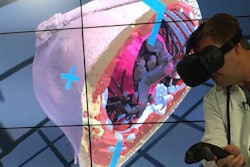The study, to be presented by medical student Kyle Malecki, aimed to investigate the accuracy of the semiautomated tool for measuring surface nodularity at CT to predict the presence of underlying liver fibrosis between stages F0 and F4.
The researchers evaluated 367 patients, including about 200 with fibrosis ranging from stage F1 all the way to F4. For discriminating significant liver fibrosis, advanced fibrosis, and cirrhosis, the receiver operator characteristics (ROC) area under the curve was 0.902, 0.932, and 0.959, respectively.
Quantification of liver surface nodularity at MDCT can serve as a useful noninvasive biomarker for staging liver fibrosis, the group concluded.
"This is a really neat noninvasive tool that can be retrospectively applied to CT scans to assess for liver fibrosis," Dr. Perry Pickhardt told AuntMinnie.com. "It rivals MR/ultrasound elastography in accuracy but doesn't require extra equipment or prospective planning."



















